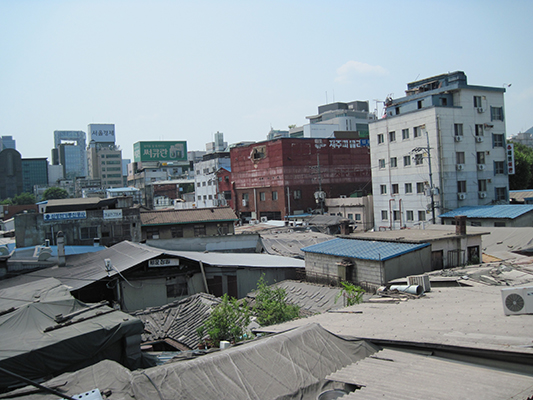
While the government and private developers have frog-marched the major areas of Seoul into a western image, huge swaths of Seoul continue to embody the haste of a post-Korean War redevelopment plan. Though at first glance the blocks may seem to be laid out in a grid, they are not. What looks to be grids is a superblock structure with dendritic alleys that pierce into the bowels of these blocks. Historically, rectangular buildings along the edges of these blocks housed shops and commercial functions. The long side of rectangle faced the street, allowing less density of frontage along the street. In some instances, these one-and-two story structures have given way to midrise commercial and office. This shiny new exterior only serves to further distance us from life inside of these blocks. The interior buildings house both residential and commercial functions and are tightly packed and impenetrable to visitors.
Walking back into the bowls of these untouched superblocks blocks, the only word to describe it is sublime. This part of Seoul is dark and uncertain and confusing. The low, densely packed hovels leer at visitors and dare them to find their way out or through. Narrow alleys wind without any sense of reason, and they can suddenly taper and dead end into a private gate. The people living and working in these interiors seem rougher and more of-the-city than the polished and pressed citizens parading down the main commercial streets. One old woman grilling white fish beckons to me to eat in her restaurant (although with six plastic chairs around a communal table the word hardly applies.) When she brings me the fish, she sets it in front of me and then, hands bare and black with soot, she debones it and gestures that I should eat.
When redeveloping these blocks, the government is taking a clear-all approach. Developers buy the packaged parcels and wipe away all existing housing but and any trace of the former urban form. Designers then set L-shaped towers on a lawn creating a sterile living environment. It is modern in the worst sense of the word. Design wise, this approach is obviously the path of least resistance. It is difficult to decipher the enigmatic form of the alleys that change superblock by superblock. No one solution can be proposed to sensitively keep echoes of existing urban fabric within these blocks. Redevelopment will have to happen incrementally in order to retain some of the original pathos of Seoul. With the onset of the world financial crisis in 2009, Seoul's appetite for wide-sweeping redevelopment projects is starting to wane. Hopefully a new approach to urban design in Seoul will take hold.
